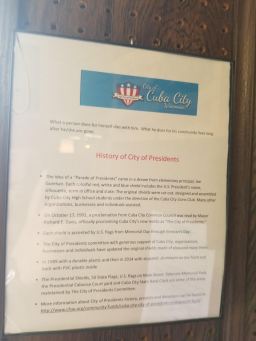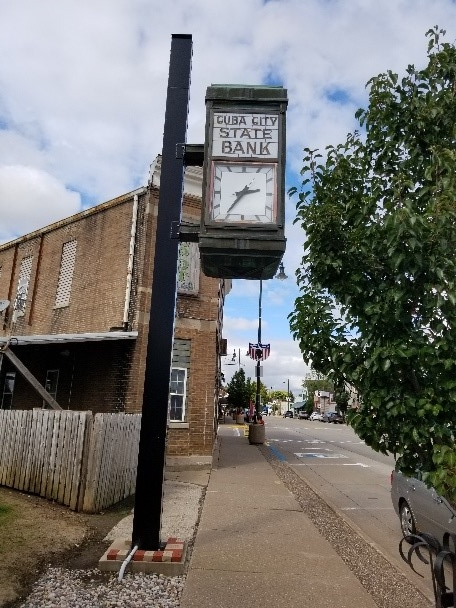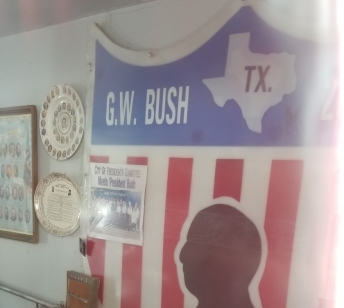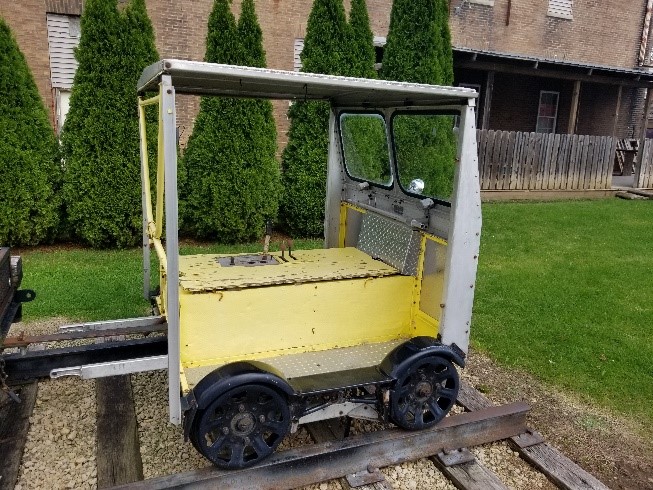You might be thinking – what is there to do around here that I haven’t already done? Well, for starters, most people in the Wisconsin area have probably not played rugby before. Along with being a great game, rugby is a sport that most people in this part of the world learn by playing (although I’ll introduce you to some of the basics in this article.) Most of the road trips I go on, especially in the fall, are to rugby competitions. But rugby, unlike a lot of other team sports, is just as much about the fraternizing afterwards as the game itself.
Interested? Then read on! First, I’ll introduce some of the basics of the game, then teach you some of our after-game songs, and after that, tell you about some of the rugby opportunities here in Southwest Wisconsin.

The 2019 UW-Platteville Men’s Rugby team (Photo: Courtesy of the Platteville Men’s Rugby Club Facebook Page)
Rugby basics and background

I like to think of rugby as the estranged love-child of the two sports, soccer and American football. Rugby has the physicality of football, with the pace and kicking skills required in the soccer realm. The goal of rugby is very similar to football and soccer, you want to score more points than the opposing team. In order to score, you have to touch the ball to the ground in the tryzone. This is called a try and is worth five points. A tryzone is like the endzone in football: there is one on each end of the field. The field is 100 meters in length and 70 meters in width. An example of how a rugby field, called a “rugby pitch” looks is shown in the photo above, from the 2015 Rugby World Cup.
Another way points are scored is by kicking the ball through the posts, centered at the beginning of each tryzone. An offensive player can kick the ball at any time during the match, if it goes through the posts they are awarded three points. However, the ball must be a drop kick that touches the ground first, before being kicked. After a try is scored, there is an opportunity to kick the ball through posts, and this attempt is worth two points.
The best way to describe a rugby ball, is to call it an undersized watermelon. Rugby balls are in the shape of an ellipse, similar to a football, but much more rounded at the points and larger overall.
Offensive players are allowed to pass, run, or kick the ball. In rugby, you are only allowed to pass the ball backwards. If you want to play the ball forwards, it has to be kicked. The opposing players defend by tackling the offensive player to the ground. In this sport there are no pads or helmets, therefore tackling rules are much stricter in order to keep players safe.

Once a player is tackled, the ball carrier must release the ball onto the ground or to a teammate. Offensive players form a ruck to keep possession of the ball. They form over the ball-carrier to protect him and clear any defenders off of the ball. Another offensive player, called the scrumhalf, will take the ball off of the ground and pass the ball to a teammate.

Rugby is very similar to soccer in multiple ways as well. In contrast to football, there are no breaks between plays. Each team has 15, 10, or 7 people depending on which format of rugby you playing. 15-person rugby, or 15s, is played in two 40-minute halves, 10s rugby in two 10-minute halves, and 7s rugby in two 7-minute halves. Time only stops for injuries and certain penalties. Like soccer players, rugby personnel must be able to play most, if not all of the game. Teams cannot substitute players in and out. Once a player is substituted out, they cannot come back into the game.
Another comparison to soccer are the restarts: most breaks in play result in free kicks or penalty kicks. The ball is also kicked to start the game, after halftime, and after any scoring play. There are so many similarities between these sports that it really is as if soccer and football had a child, rugby being the offspring.

The most unique quality of a rugby match is the scrum. A scrum results whenever the ball is thrown or dropped forward by an offensive player and can also be an alternative to free kicks during a penalty play. During a scrum, bigger players – denoted as forwards – from both teams bind together. The ball is placed in the middle of the scrum and the objective is to drive the other team off of the ball to gain possession. This tug-of-war situation highlights which team is stronger and more conditioned, and it also highlights which team has been skipping leg day.

A scrum: players pushing against each other for possession of the ball (Photo: C
Why should you play rugby?

I play here in southwest Wisconsin on the men’s UW-Platteville rugby team. My friend and teammate, Erik Wohlfiel, let me use one of his Instagram posts (above) . This post immediately caught my attention because it perfectly sums up why people are so drawn to the game of rugby. The main reason to play this sport for me, and my teammates, is the camaraderie.
There is honestly no other reason I would want to drive about six hours to Duluth, Minnesota on a Saturday, in a car filled with five teammates and their gear. It’s an interesting experience partaking in country-karaoke and listening to comedic podcasts with friends on these long drives to away games. Our team here at UW-Platteville is currently sponsored by Steve’s Pizza Palace. On Thursday we head over to Steve’s to participate in trivia night, which is open to anybody. It’s a good time to spend with friends, test our knowledge, and support our sponsor. We also volunteer about once a month to help out at Ruby’s Pantry, which is in association with Platteville United Methodist Church. The men and women’s clubs hold a banquet at the end of each year for the members only. This is the most formal annual event of the year where players are encouraged to bring a date and dress nicely. Player awards for achievements such as ‘hardest-hitter’ and ‘most-improved’ are handed out at the banquet as the fall-league season is celebrated and reviewed.

Furthermore, the quote that Erik’s post refers to speaks about the brotherhood/sisterhood formed from playing the sport. When you go get tackled or go down in a game, you will always have a teammate to protect you and you’re your back. This bond extends off the field as well and you often build long-term friendships through rugby-related events.
You also get to visit and view many different areas of Wisconsin in the process, as well as the edges of Minnesota and Michigan. In addition, you get to interact with and meet new people from all of these areas.
What is a rugby social?
This brings me to the most unique aspect of rugby, which is the socials. A social is an after-party or a post-match gathering, if you will. Both teams just got done beating the snot out of each other for an upwards of 80 minutes, but yet we can all be friends. This is very different from other sports where competition is the most important part and in most other sports it is looked down upon to fraternize with the opposing team.
In club rugby, fraternizing is one-hundred percent welcomed. I’m not exactly sure if this happens in youth-rugby (I’ve gotten mixed signals from my teammates about this). However, in college club teams and adult leagues it is traditional for the home team to host a social after each game. It isn’t unusual for the referee or coaches to come and hang out at this event either. This is where you are introduced to the culture that is rugby and some of the activities that rugby players like to do here in southwest Wisconsin.
Some of the activities common at socials include jousting and singing round songs. Since there are adults and people of age 21 and older at these socials, rugby players of legal age like to participate in a drinking game called a ‘boat race.’ The jousting consists of two players from each team. One player from each team will be the base, and the other player will be on their shoulders holding a goal post pad used to simulate a lance. The two people at the base will start running at each other, and the top two people will try to knock each other off of the other person’s shoulders. This is a fun activity at the social where anyone can get involved or watch for some laughs.
The boat race is a beer-drinking relay race that features around four to six players from each team for participation. Each participant will have two beers, one in each hand. Each team of four to six will be seated on the ground as if they were in a row boat, close together and all facing forward. The two ‘row boat’ teams will be facing an individual who starts the race. The starter commands the teams to row and points a hand to the sky. The teams listen to the command and make a rowing motion with the two beers, making sure not to spill, because that could be a potential disqualification. They continue making rowing motions until the starter drops his hand back down to his side, signaling the start of the race. Each person in the relay drinks their first beer as fast as they can. Once, they are finished they put the empty can, or solo cup, on the top of their head to signal to the next man in the boat to start drinking his beer. This continues down the ‘row boat’. The person in the last seat of the boat finishes both of their beers and sends the relay in the opposite direction for the rest of the team to finish their second beer, down-and-back style. This is always an extra competition that both teams really enjoy. It draws the biggest crowds at the social and people will cheer on their respective teams.
Rugby Songs
The round songs follow a general format, their purpose is to generate comedic punchlines. Each verse will be sung by a soloist and then the rest of the group will join in for a refrain. Everyone at the social stands in a big circle and sings along. Anyone can sing a solo punchline, but they have to signal to the group that it is their turn to go. A soloist signals to the group by putting their hand over their forehead. The rest of the group will point with their elbow at the person who is signaling. This is the system the group has used to determine whose turn it is to sing.
One of the most popular songs we sing is called “Yogi Bear.” This the format of the song:
(Soloist)
“I know a bear that you all know!”
“Yogi, Yogi!”
(Chorus)
“I know a bear that you all know! Yogi, Yogi bear.”
“Yogi, Yogi bear—“
“Yogi, Yogi bear!”
“I know a bear that you all know! Yogi, Yogi bear.”
The soloist who signals would come up with the next punchline (sorry Chicago Bear fans).
(Soloist)
“Yogi sucks at football!”
“Chicago, Chicago!”
(Chorus)
“Yogi sucks at football! Chicago, Chicago bears.”
“Chicago, Chicago bears—“
“Chicago, Chicago bears!”
“Yogi sucks at football! Chicago, Chicago bears.”
This second song is another popular pick, it’s a comedic song that uses the idea of Jesus not having enough apostles to play 15s rugby. The song also explains why Jesus wouldn’t be able to play rugby Himself (the song is referred to as “Jesus Saves” or “Jesus Can’t Play Rugby.”)
(Soloist)
“Jesus can’t play rugby, because he only has twelve friends!”
(Chorus)
“Jesus can’t play rugby, ‘cause he only has twelve friends!”
“Jesus can’t play rugby, ‘cause he only has twelve friends!”
“Jesus saves, Jesus saves!”
“Jesus saves—”
This follows the same format as the last song and a new soloist will start the next round.
(Soloist)
“Jesus can’t play rugby, because his dad will rig the game!”
(Chorus)
“Jesus can’t play rugby, ‘cause his dad will rig the game!”
“Jesus can’t play rugby, ‘cause his dad will rig the game”
“Jesus saves, Jesus saves!”
“Jesus saves—”
Then after a few rounds the song ends like this.
(Soloist)
“Jesus, we’re only kidding!”
(Chorus)
“Jesus, were only kidding!”
“Jesus, were only kidding!”
“Jesus saves, Jesus saves!”
“Jesus saves!”
Rugby opportunities in southwest Wisconsin
Many of the opportunities to play here in Wisconsin are in relation to the organization known as the Wisconsin Rugby Football Union. This organization hosts rugby leagues for all ages classified into three categories – youth, collegiate, and senior club. Their page has information regarding upcoming events, resources, and registered club teams. For every level the sport is easily accessible. Anyone is welcome to join these clubs, and there are plenty of schools around the state participate for middle school, high school, and college students, as well as seniors (anyone who is out of school). There is collegiate match-play every Saturday, even if you aren’t interested in playing, rugby is an entertaining sport to watch and support. You could even study up on the rule book and become a referee, if that’s something you are interested in. There are also plenty of tournaments and events where spectators are welcome to hangout, buy apparel, and get something to eat.
Popular tournaments in Wisconsin
Collegiate leagues take place in the fall from September through November. In the spring and summer, there are a lot of open tournaments that any team can register to play in, or individual players can participate in. Especially in summer, a lot of teams are lacking players and will take anyone who’s ready to go. Many tournaments we participate in don’t require a specific roster so teams are allowed to borrow players from each other if they need substitutes or don’t have enough players.
One of our favorite tournaments to participate in is Whiskey Ten’s. This is a ten versus ten tournament at the Dan Ryan Woods in Chicago Illinois. The South Side Irish rugby club has been hosting this event annually in the spring, I’m not sure when it originally started. This tournament guarantees three matches for each team. Men and women’s teams at both the senior and collegiate level participate in this tournament. The three-field area has an apparel and food tent for spectators and participants. Anyone is welcome to come watch teams play a lot of rugby. There are plaques handed out to the top-placed teams. There is a social after the tournament at Kelly’s Irish Saloon that serves dinner for the players.
Another example of a tournament is Pigfest which is hosted by the Oshkosh Rugby club. Pigfest takes place in Oshkosh, Wisconsin and is the longest running 10s rugby tournament in the Midwest. This tournament is a summer tournament, usually sometime in July. UW-Platteville won both of their games at this tournament last year, before it down-poured and the remainder of the event was called off. This even has been called Pigfest because guests are welcome to some great food. The tournament offers rotisserie pig, burgers, beer and other beverages.
Platteville’s Mudfest
Our own club team at UW-Platteville hosts an annual tournament called the Mudfest. This tournament is a 15s tournament that has been running annually for 24 years. 2020’s upcoming Mudfest will be the 25th anniversary of the event.

The image above shows some of the usual teams that register for our tournament. That schedule was specifically for the Men’s college and senior bracket, women’s teams participate in this tournament as well. Rugby is the main event, where the winning team can play an upwards of five 80-minute games. This tournament is truly and iron-man competition to see who has the most conditioned and disciplined squad. In 2019, our UW-Platteville Men’s club was able to win the tournament. We won four games and only lost one match to the UW-Platteville Men’s Alumni team.

This event draws a large crowd each year and is celebrated by citizens in the city of Platteville. Depending on planning, there are extra events after the rugby-playing is over. In 2017, the city decided to block of sections of Mineral Street to allow for a band. This has happened numerous times over the years to allow for block parties and event participants to celebrate in an organized environment.

Just like the other tournaments that were mentioned, Mudfest sells food and beverages. Last year our sponsor, Steve’s Pizza Palace, sold pizza slices at the event. Volunteer members from the WSUP radio station also participated in last year’s Mudfest by dj-ing. They played music and made announcements for the duration of the tournament.

Overall, Mudfest is a celebration of rugby and the history of Platteville. Aside from Diary Days, this rugby tournament is one of the most celebrated and long-standing events in the area.
Get Involved
I hope this has given you a better understanding of rugby and the opportunities it presents in southwest Wisconsin. If you and your friends are ever bored on a weekend or want to get involved in a new hobby, then rugby is here for you. Rugby has opportunities for everyone at varying levels of participation. I’ve definitely enjoyed my time playing for the UW-Platteville Men’s Rugby club and made numerous memories I will never forget on and off the field. Therefore, I encourage anyone who has taken the time read this – to get involved or get out and support your local rugby club!













































































